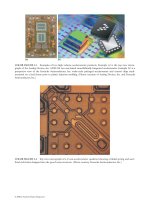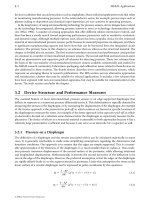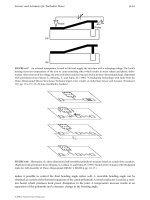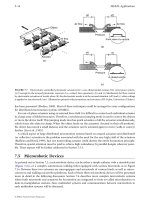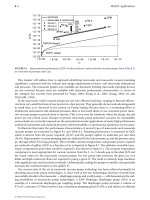Engineering Materials Vol II (microstructures_ processing_ design) 2nd ed. - M. Ashby_ D. Jones (1999) WW Part 15 doc
Bạn đang xem bản rút gọn của tài liệu. Xem và tải ngay bản đầy đủ của tài liệu tại đây (159.8 KB, 14 trang )
Teaching yourself phase diagrams 369
Fig. A1.56.
precipitates
ε
and
ε
precipitates
β
. Just above 600°C
18
53
(= 34%)
ε
(65% B) +
35
53
(=
66%)
β
(12% B). At 600°C all
β
forms
α
and
ε
in eutectoid reaction. Just below
600°C
25
60
(= 42%)
ε
(65% B) +
35
60
(= 58%)
α
(5% B). 600°C → 300°C,
α
precipitates
ε
and
ε
precipitates
α
. Just above 300°C
27
66
(= 41%)
ε
(69% B) +
39
66
(= 59%)
α
(3% B).
At 300°C all
ε
and some
α
form
δ
in peritectoid reaction. Just below 300°C
27
37
(=
73%)
δ
(40% B) +
10
37
(= 27%)
α
(3% B). 300°C → 0°C, amount of
α
decreases and
δ
increases. At 0°C
30
35
(= 86%)
δ
(35% B) +
5
35
(= 14%)
α
(0% B).
370 Engineering Materials 2
Appendix 2
Symbols and formulae
List of principal symbols
Symbol Meaning(units)
Note: Multiples or sub-multiples of basic units indicate the unit suffixes normally
used in materials data.
a lattice parameter (nm)
a crack length (mm)
A availability (J)
A
1
eutectoid temperature (°C)
A
3
first ferrite temperature (°C)
A
cm
first Fe
3
C temperature (°C)
b Burgers vector (nm)
c height of c.p.h. unit cell (nm)
C concentration (m
−3
)
CCR critical cooling rate (°C s
−1
)
DP degree of polymerisation (dimensionless)
E Young’s modulus of elasticity (GPa)
f force (N)
F force (N)
g acceleration due to gravity on the Earth’s surface (m s
−2
)
G shear modulus (GPa)
G Gibbs function (J)
G
c
toughness (kJ m
−2
)
H hardness (GPa)
∆H latent heat of transformation (J)
I second moment of area of structural section (mm
4
)
k ratio of C
solid
/C
liquid
on phase diagram (dimensionless)
k Boltzmann’s constant (J K
−1
)
k shear yield strength (MPa)
K
IC
fracture toughness (MPa m
1/2
)
L liquid phase
Symbols and formulae 371
Symbol Meaning(units)
m mass (kg)
m Weibull modulus (dimensionless)
M bending moment (N m)
M
F
martensite finish temperature (°C)
M
S
martensite start temperature (°C)
n time exponent for slow crack-growth (dimensionless)
p pressure (Pa)
P
f
failure probability (dimensionless)
P
S
survival probability (dimensionless)
q activation energy per atom (J)
Q activation energy per mole (kJ mol
−1
)
r* critical radius for nucleation (nm)
R universal gas constant (J K
−1
mol
−1
)
T absolute temperature (K)
T
e
equilibrium temperature (K)
T
g
glass temperature (K)
T
m
melting temperature (K)
∆T thermal shock resistance (K)
ν
velocity (m s
−1
)
V volume (m
3
)
V volume fraction (dimensionless)
W
A
weight % (dimensionless)
W
f
free work (J)
X
A
mol % (dimensionless)
α
linear coefficient of thermal expansion (MK
−1
)
γ
energy of interface (J m
−2
) or tension of interface (N m
−1
)
δ
elastic deflection (mm)
ε
true (logarithmic) strain (dimensionless)
ε
f
(nominal) strain after fracture; tensile ductility (dimensionless)
ε
.
ss
steady-state tensile strain-rate in creep (s
−1
)
η
viscosity (P, poise)
ν
Poisson’s ratio (dimensionless)
ρ
density (Mg m
−3
)
σ
true stress (MPa)
σ
c
(nominal) compressive strength (MPa)
σ
r
modulus of rupture (MPa)
σ
TS
(nominal) tensile strength (MPa)
σ
y
(nominal) yield strength (MPa)
Greek letters are used to label the phases on phase diagrams.
372 Engineering Materials 2
Summary of principal formulae and magnitudes
Chapter 3 and Teaching yourself phase diagrams: phase diagrams
Composition is given by
W
A
=
weight of A
weight of A weight of B+
× 100
in weight %, and by
X
A
=
atoms (mols) of A
atoms (mols) of A atoms (mols) of B+
× 100
in atom (mol) %.
W
A
+ W
B
= 100%; X
A
+ X
B
= 100%.
Three-phase reactions
Eutectic: L a
α
+
β
Eutectoid:
β
a
α
+ γ
Peritectic: L +
α
a
β
Peritectoid: A + B a
δ
Chapter 4: Zone refining
C
s
=
Ck
kx
l
0
11 ( )exp .−− −
C
s
= concentration of impurities in refined solid; C
0
= average impurity concentration;
k = C
solid
/C
liquid
; x = distance from start of bar; l = zone length.
Chapter 5: Driving forces
Driving force for solidification
W
f
= −∆G =
−−
∆H
T
TT
m
m
( ).
∆H = latent heat of solidification; T
m
= absolute melting temperature; T = actual tem-
perature (absolute).
Driving force for solid-state phase change
W
f
= −∆G =
−−
∆H
T
TT
e
e
( ).
∆H = latent heat of transformation; T
e
= equilibrium temperature (absolute).
Symbols and formulae 373
Chapter 6: Kinetics of diffusive transformations
Speed of interface
ν
∝ e
−q/kT
∆T.
q = activation energy per atom; k = Boltzmann’s constant; T = absolute temperature;
∆T = difference between interface temperature and melting or equilibrium temperature.
Chapter 7: Nucleation
Nucleation of solids from liquids: critical radius for homogeneous and heterogeneous
nucleation
r* =
2
γ
SL
T
HT T
m
m
∆ ( )
.
−
γ
SL
= solid–liquid interfacial energy; T
m
= absolute melting temperature; ∆H = latent
heat of solidification; T = actual temperature (absolute).
Chapter 8: Displacive transformations
Overall rate of diffusive transformation
∝ no. of nuclei × speed of interface.
Chapter 10: The light alloys
Solid solution hardening
σ
y
∝
ε
s
C
32 12//
.
C = solute concentration;
ε
s
= mismatch parameter.
Work-hardening
σ
y
∝
ε
n
.
ε
= true strain; n = constant.
Chapter 14: Metal processing
Forming pressure
No friction
p
f
=
σ
y
.
374 Engineering Materials 2
Sticking friction
p
f
=
σ
y
wx
d
1
2
()
.+
−
/
σ
y
= yield strength; w = width of forging die; x = distance from centre of die face; d =
distance between dies.
Chapter 17: Ceramic strengths
Sample subjected to uniform tensile stress
Tensile strength
σ
TS
=
K
a
m
IC
π
.
K
IC
= fracture toughness; a
m
= size of widest microcrack (crack width for surface crack;
crack half-width for buried crack).
Modulus of rupture
σ
r
=
6
2
M
bd
r
.
M
r
= bending moment to cause rupture; b = width of beam; d = depth of beam.
Compressive strength
σ
c
≈ 15
σ
TS
,
σ
c
=
CK
a
IC
π
.
C = constant (≈15);
a
= average crack size.
Thermal shock resistance
∆T =
σ
TS
/E
α
.
E = Young’s modulus;
α
= linear coefficient of thermal expansion.
˙
exp( ).
εσ
ss
n
AQRT=−/
ε
.
ss
= steady-state tensile strain rate; A, n = constants;
σ
= tensile stress; Q = activation
energy for creep; R = universal gas constant; T = absolute temperature.
Chapter 18: Statistics of fracture
Weibull distribution
P
s
(V ) =
exp −
V
V
m
00
σ
σ
Symbols and formulae 375
or
ln ln ln ln .
1
00
P
V
V
m
s
=+
σ
σ
P
s
= survival probability of component; V = volume of component;
σ
= tensile stress on
component; V
0
= volume of test sample;
σ
0
= stress that, when applied to test sample,
gives P
s
= 1/e (= 0.37); m = Weibull modulus.
Failure probability
P
f
= 1 − P
s
.
Slow crack-growth
σ
σ
TS
(test)
=
n
t
t
.
σ
= strength of component after time t;
σ
TS
= strength of component measured over
time t(test); n = slow crack-growth exponent.
Chapter 19: Ceramics processing
Sintering
d
d
/
ρ
t
C
a
QRT
n
exp( ).=−
ρ
= density; t = time; C, n = constants; a = particle size; Q = activation energy for sinter-
ing; R = universal gas constant; T = absolute temperature.
Glass forming
η
∝ exp(Q/RT).
η
= viscosity; Q = activation energy for viscous flow.
Chapter 20: Cements and concretes
Hardening rate ∝ exp(–Q/RT).
Q = activation energy for hardening reaction; R = universal gas constant; T = absolute
temperature.
Chapter 23: Mechanical behaviour of polymers
Modulus: WLF shift factor
log(a
T
) =
CT T
CTT
11 0
210
( )
.
−
+−
376 Engineering Materials 2
C
1
, C
2
= constants; T
1
, T
0
= absolute temperatures.
Polymer viscosity
ηη
10
11 0
210
exp
( )
.=
−−
+−
CT T
CTT
Chapter 25: Composites
Unidirectional fibre composites
E
c||
= V
f
E
f
+ (1 − V
f
)E
m
,
E
V
E
V
E
f
f
f
m
c⊥
−
=+
−
.
1
1
E
c||
= composite modulus parallel to fibres; E
c⊥
= composite modulus perpendicular to
fibres; V
f
= volume fraction of fibres; E
f
= Young’s modulus of fibres; E
m
= Young’s
modulus of matrix.
σ
TS
=
VV
f
f
f
f
y
m
σσ
( ) .+−1
σ
TS
= tensile strength parallel to fibres;
σ
f
f
= fracture strength of fibres;
σ
y
m
= yield
strength of matrix.
Optimum toughness
G
c
=
V
d
f
f
f
s
m
()
.
8
2
σ
σ
d = fibre diameter;
σ
s
m
= shear strength of matrix.
Magnitudes of properties The listed properties lie, for most structural materials, in the ranges shown
Property Metals Ceramics Polymers Composites
(unfoamed) (polymer
matrix)
Density (Mg m
−3
) 2 to 10 1 to 5 1 to 2 1.5 to 2.0
Young’s modulus (GPa) 50 to 200 10 to 1000 0.01 to 10 10 to 200
Yield strength (MPa) 25 to 1500 3000 to 50,000 – –
Tensile strength (MPa) 50 to 2000 1 to 800 5 to 100 100 to 1000
Fracture toughness (MPa m
1/2
) 5 to 200 0.1 to 10 0.5 to 5 20 to 50
Creep temperature (°C) 50 to 1000 −20 to 2000 0 to 200 0 to 200
Index 377
Index
Adhesives 204, 260
Age hardening see Precipitation hardening
Alexander Keilland oil platform 136
Alloy 15, 25, 321
Alumina 163, 164, 167
Aluminium-based alloys 8, 12, 100 et seq.,
347, 351
Amorphous
metals 96
polymers 236
structure 16
Anisotropy 266, 280, 316
Annealing 151
Atactic polymers 231
Austenite 114, 130, 355
Availability 50
Bain strain 84
Bakelite 221
Beryllium 100
Binary alloy 25, 327, 336
Boiler design 133
Bone 164, 165
Borosilicate glass 162, 165
Boundaries 18
Boundary tension 22
Brass 7, 12, 342
Brick 163, 201
Bronze 7, 12, 356
Carbide formers 129
Carbon equivalent 138
Carbon fibres see CFRP
Carburising 155
Case studies
in ceramics and glasses 190, 303
in design 296 et seq.
in phase diagrams 34 et seq.
in phase transformations 89 et seq.
in steels 133 et seq.
Casting 91, 121, 144
Casting defects 144
Cast iron 6, 12, 121
Catalysis 91, 93
C-curves see TTT curves
Cellular solids 272 et seq.
Cellulose 224, 279
Cement and concrete 163, 207 et seq.
chemistry 207
strength 212
structure 210
Cementite 114 et seq., 355
Ceramics 161 et seq.
brittle fracture 180, 185 et seq.
case studies in 190, 303
cement and concrete 207 et seq.
production, forming and joining 194 et seq.
properties 164, 177 et seq.
structures 167, 174 et seq.
Cermets 164, 203
CFRP 164, 263 et seq., 317
Chain-folded crystals 233
Chemical reactions 47
Chemical vapour deposition 198
China 163
Coherent interfaces 20, 83, 107
Cold drawing 248, 249
Columnar crystals 91, 144
Components 22, 25, 321
Composites 165, 203, 215, 263 et seq.
case studies in 312 et seq.
Composition 25, 321, 336
Compounds 17
Compression moulding 257, 259
Compressive strength 182, 213
Concentration 321
378 Index
Constitution 22, 30, 324
Constitution point 27, 336, 337
Continuous casting 145
Conveyor drum design 296
Co-polymers 255
Copper-based alloys 6, 12, 30, 31, 356,
361
Corrosion 129
Cooling curves 333
Covalent ceramics 167, 170
Crazing 248, 250
Creep of ceramics 183
Critical nucleus 69
Cross-linked polymers 221, 226
Crystal growth 91
Crystal structure of
ceramics 168
metals 14
polymers 233
Cupronickel 7
Dacron 221
Data for
ceramics and glasses 163, 165
composites 265
metals 11
polymers 224, 225
woods 278
Decomposition of polymers 246
Degree of polymerisation 228
Dendrites 65, 92, 352
Density of
ceramics and glasses 164
foams 272
metals 12
polymers 224
woods 278
Design-limiting properties 289
Design methodology 291, 292
Diamond 164
Die casting 145
Differential thermal analysis 334
Diffusion bonding 204
Diffusion-controlled kinetics 63
Diffusive transformations 57 et seq.
Displacive transformations 76 et seq.
Driving force 46 et seq.
Duralumin 103
Dynamic equilibrium 61
Elastic constants see Moduli
Elastomers 221, 224, 232, 244
Energy-efficient forming 155
Enthalpy 52
Entropy 49
Epoxies 221, 224
Equiaxed crystals 92, 142
Equilibrium 28, 51, 61
Equilibrium diagrams 25 et seq.
case studies 34 et seq.
teach yourself 326 et seq.
Eutectics 35, 42, 114, 346 et seq.
Eutectoids 346 et seq.
Extrusion 258
Fatigue 298
Ferrite 114 et seq., 355
Ferrous alloys 6, 10
Failure probability 185
Failure analyses 133, 296
Fibres 260, 263
Foams 263, 272
Forging 147
Formica 223
Forming of 194
ceramics and glasses 194 et seq.
composites 264
metals 143 et seq.
polymers 254 et seq.
Formulae 372 et seq.
Forsterite 173
Fracture strength of
ceramics and glasses 164, 180
composites 267
metals 13
polymers 225, 248
woods 278
Fracture toughness of
ceramics and glasses 164, 180
composites 265, 269
metals 13
polymers 225
woods 278
Free work 50
Germanium 39
GFRP 219, 263 et seq., 317
Gibbs’ function 53
Gibbs’ phase rule 341
Index 379
Glasses 161 et seq.
brittle fracture 185 et seq.
production, forming and joining 97,
198 et seq.
properties 177 et seq.
structure 167 et seq.
Glass fibres see GFRP
Glass temperature 225, 235, 239
Glass transition 239
Glassy metals 63, 97
Glaze bonding 204
Glazes 202
GP zones 106
Grain
boundaries 18
growth 55, 137
shape 20, 64
size 93
strengthening 153
Grains 20
Granite 164, 175
Graphite 121
Habit plane 83
Hammer design 139
Hardenability 125
Heat 48
Heat-affected zone 137
Heat flow 62
Heterogeneous nucleation 69, 90
Homogeneous nucleation 69
Hot isostatic pressing 196
Hot pressing 196
Hydrogen cracking 138
Hydroplastic forming 194, 201
Ice 41, 51, 89, 164, 303, 335
Incoherent interfaces 20, 107
Induction hardening 122
Injection moulding 257
Inoculants 93
Instability 50
Integrated circuits 94
Internal energy 47
Interstitial solutions 16
Intrinsic strength 178
Investment casting 146
Ion implantation 155
Ionic ceramics 167, 168
Iron-based alloys 5, 12
Isotactic polymers 231
Joining
of ceramics and glasses 204
of metals 154
of polymers 260
Jominy test 126
Kevlar fibres see KFRP
KFRP 219, 271
Kinetics 59 et seq.
Lead-tin alloys 12, 26, 34, 326 et seq.
Ledeburite 115
Lever rule 339
Light alloys 100 et seq.
Lignin 224, 279
Liquid phase sintering 197
Limestone 164
Linear polymers 220, 225
Machining 153
Magnesia 168
Magnesium-based alloys 100 et seq.
Martensite 83, 118, 134, 137, 140
Mechanical properties of
cement and concrete 212 et seq.
ceramics and glasses 164, 177 et seq.
composites 265 et seq.
foams 273
metals 12, 101, 118, 140 et seq.
polymers 224, 238 et seq.
woods 277 et seq.
Melt spinning 98
Memory alloys 87
Metals 3 et seq.
case studies in 133 et seq.
equilibrium diagrams for 25 et seq.
glassy 63, 97
light alloys 100 et seq.
production, forming and joining
143 et seq.
properties 12, 13, 101
steels 113 et seq.
structure 14 et seq.
Metastability 50
Microchips 39
Microstructure 323 et seq.
380 Index
Moduli of
ceramics and glasses 164, 177
composites 265, 266
foams 273
metals 12
polymers 224, 239
woods 278
Modulus of rupture 164, 181
Monel 7, 12
Mould design 308
Moulding 200, 257
Mullite 173
Mylar 221
Neoprene 223
Network ceramics and glasses 167
Nickel-based alloys 7, 12
Nitriding 155
Normalisation of steels 113
Nucleation 68, 73, 77, 89 et seq.
Nylon 222, 224, 255, 312
Offshore structures 303
Optimised materials 264, 270, 275
Pearlite 64, 115 et seq.
Peritectic 359
Peritectoid 380
Phase boundaries 18, 21
Phase diagrams 26 et seq., 326
case studies 34 et seq.
teach yourself 320 et seq.
Phase reactions 348
Phase transformations 46 et seq., 89
Phases 18, 25, 323
Phenol-formaldehyde 223, 224
Plasticisers 256
Plumbers solder 34, 35
Polyacrylonitrile 221
Polybutadiene 223, 224
Polychloroprene 223, 224
Polyester 223, 224
Polyethylene 222, 224
Polyethyleneteraphthalate 221
Polyisoprene 216, 217, 247
Polymers 219 et seq.
case studies in 308
production, forming and joining 254 et seq.
properties 238 et seq.
structure 228 et seq.
Polymethylmethacrylate 222, 224, 246, 312
Polymorphism 16
Polypropylene 222, 224, 312
Polysilicon 95
Polystyrene 222, 224
Polytetrafluorethylene 222, 224
Polyvinylchloride 222, 224, 255
Porcelain 163, 201
Porosity 43
Portland cement 163, 208
Pottery 163, 201
Powder methods 143, 145, 195 et seq.
Precipitate coarsening 54
Precipitation hardening 103, 108, 128
Production of
ceramics and glasses 194 et seq.
composites 264
metals 143 et seq.
polymers 254 et seq.
Properties of
cement and concrete 212 et seq.
composites 264 et seq.
ceramics and glasses 177 et seq.
foams 273
metals 101, 118
polymers 238 et seq.
woods 280 et seq.
Proportions of phases 338
Protein 224
Quenching and tempering 119
Radicals 230
Rain making 89
Rates of transformation see Kinetics
Rayon 254
Reaction bonding 197
Recovery 151
Recrystallisation 55, 151
Resins 221, 224
Reversibility 49
Rolling 150, 200
Salol 58
Sand casting 145
Sandstone 175
Sandwich panels 272, 318
Scale of structural features 14, 66
Seeding 91, 93
Segregation 93, 144
Semicoherent interfaces 20
Index 381
Semiconduction materials 39, 94
Sialons 163, 164
Silica 94, 167, 170
Silicates 170, 172
Silicon 39, 94
Silicon carbide 163, 164, 170
Silicon nitride 163, 164, 170
Silver iodide 90
Silver solder 34, 37
Sindiotactic polymers 231
Sintering 194
Slip casting 201
Soda glass 162, 164, 191
Sodium chloride 167
Soft solder see Lead-tin alloys
Solder see Lead-tin alloys
Solid solutions 16
Solid solution hardening 101, 108, 128
Solidification 51, 57
Spherulites 234
Spinel 173
Stability 50, 110
Stainless steels see Steels
State variables 325
Statistics of brittle fracture 185 et seq.
Steels 113 et seq., 355
alloy 125 et seq.
case studies in 133 et seq.
carbon 85, 113 et seq.
high carbon 5, 114
low carbon 5, 114
low alloy 126
medium carbon 113
mild 5, 12, 113
stainless 5, 12, 16, 129
Strength of
cement and concrete 212
ceramics and glasses 164, 178 et seq.
composites 265, 267
foams 273
metals 12
polymers 224, 251
woods 277, 283
Structure of
amorphous solids 16
ceramics and glasses 167 et seq.
compounds 16
metals 14 et seq.
polymers 228 et seq.
solid solutions 16, 322
Structural change 46 et seq.
Substitutional solutions 17
Sulphur 96
Surface energy and tension 21
Surface engineering 155
Superalloys 7, 12
Symbols 321, 370 et seq.
Synthesis of polymers 254
Teach yourself phase diagrams 320 et seq.
Ternary alloy 25, 327
Terylene 221
Thermal properties of
ceramics and glasses 165
metals 13
polymers 225
Thermal shock resistance 166, 182
Thermoplastics 220, 224, 230
Thermosets 220, 224
Time-dependent strength 189
Titanium-based alloys 10, 100, 103
Tobomorite gel 208
Traction engine 3
TTT curves 80, 98, 105, 110, 122, 123
Undercooling 63, 69
Vacuum forming 257
Vibrations 314
Viscoelastic behaviour 242
Viscosity 198, 245
Vitreous ceramics 162, 174
Vulcanisation 247, 257
Weibull statistics 185 et seq.
Welding 136, 154, 303
Wheel design 303
Window design 190
Wood 277 et seq.
case study in 312
properties 280
structure 278
Work 46
Work hardening 110, 152
Working of metals 147
Zinc 12
Zirconia 163, 164, 169, 202, 203
Zone refining 39 et seq.
382 Index

